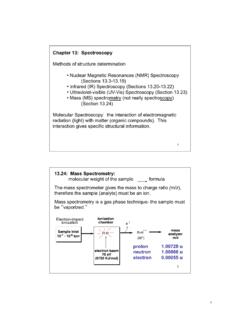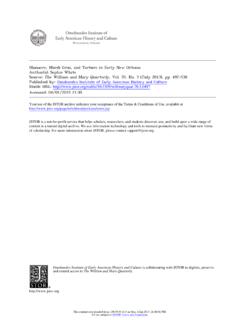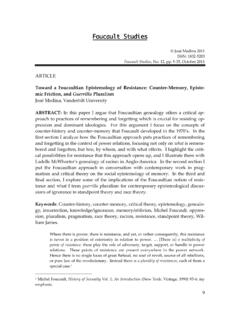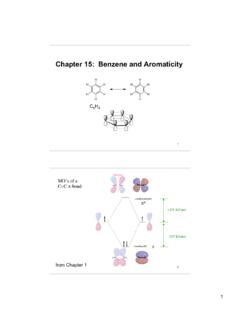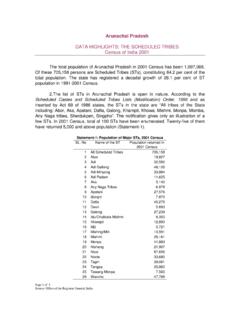Transcription of Ballet Folklórico- An Introduction
1 Ballet Folkl rico- An Introduction Folkloric dance, like the English term folk dance , means dances of the people. This type of dance reflects the traditions, cultures and beliefs of people in a particular region. Folkloric dance expresses the life and spirit of a people through its movement and music. It is both historical and current, preserving tradition yet shifting with the current times. In 1952, Amalia Hern ndez, dance teacher and choreographer at the Mexican Academy of Dance, formed the dance company known as the Ballet Moderno de M xico. With only eight members at the beginning, this small group began presenting choreographies created by Amalia herself. In this first experience as an independent artist, she debued her well-known Sones de Michoac n (Melodies of Michoac n) with indisputable success. In 1958 The Mexican Department of Tourism took notice and asked Amalia Hernandez to take her show on the road.
2 The company visited Cuba and Canada, and also participated in the Festival del Pac fico. This same year the group also traveled to Los Angeles to take part in the Mexican National Celebrations. Ms. Hern ndez was again invited to participate abroad the following year, this time at the Pan-American Games in Chicago. For this purpose, she organized a tour in which the fifty-member company adopted the name Ballet Folkl rico de M xico. among the most successful pieces performed were Los Hijos del Sol (Children of the Sun), Antiguos sones de Michoac n, El Cupidito, Fiesta Veracruzana, Los Quetzales, La Danza del Venado (Deer Dance) and Navidad en Jalisco (Christmas in Jalisco). Their successful performance in Chicago launched this folk dance company on the road to greatness. The then-president of Mexico, Adolfo Lopez Mateos, offered to make the group the best dance company in the world.
3 Soon after, the National Institute of Fine Arts scheduled a weekly performance by Hernandez dance group. On October 11, 1959, the permanent program of the group began. Currently the Ballet Folkl rico de M xico has given over 5,000 performances and has been honored with more than 200 awards recognizing their efforts. History of Mexican Dance Ritual Dance Before the Spanish conquest the Indians had magnificent dance art. They put on great spectacles in which sometimes hundreds of dancers participated. Many of the dances involved acrobatic feats and incorporated colorful costumes adorned with jewels, gold, and flowers. They also made use of masks, rattles, drums, primitive wind instruments and songs for accompaniment. Ritual dances of the Indians were about the birth of the sun, the harvest, rain, hunting, fishing, combat, victory, the offering of human sacrifices, marriage, death and burial, home building, and other domestic and religious functions.
4 One example is the Aztecs and their numerous religious festivals, in which both sexes participated in songs and dances. There were processions of women and children crowned with garlands of flowers and bearing offerings of fruits, ripened maize, and other products of the land. In contrast, the religious dances offered human sacrifices to the Gods and were quite disturbing to the Spanish settlers. Everyone participated in the dances, upper classes, lower classes, warriors, priests , and even the king. Dancing and singing was obligatory for children in school. They danced in temples, palaces, homes, streets, and large courtyards where sometimes a platform of wood or stone was erected high enough to enable the dancers to be seen from all sides. Early accounts refer to dances done in circles and concentric circles, or in single file lines face to face, advancing, retreating, and exchanging places.
5 Sometimes they danced in imitation of animals, birds, and butterflies. Ritual dances were performed mostly by men, but in some dances women participated. When men and women danced in the same dance there was no body contact. The Conquest and Spanish Influence Dance in central Mexico continued untouched by Western influence until Hernan Cort s arrived in 1519. Looking for power and victory for Spain, Cort s began to conquer the indigenous people. In the conquest and the subsequent colonization, they destroyed much of what was beautiful of the Indian civilizations and also broke the hold of the Aztec religion and sacrifices. What they brought with them, in exchange, was the culture of Spain s artistic golden age. Spain s golden age was marked by the richness of its folk music and dance, incorporating the influences of the Greco-Roman, Byzantine, Muslim, and Basque cultures.
6 The early dances Spaniards brought with them were their own religious festivals of pre-Lenten Carnival, Christmas, Holy Week, Corpus Christi, and saints days. They, like the Aztecs, danced in religious and solemn ceremonies as well as in times of celebration. The monks brought miracle and mystery plays, from which Los Moros, or The Battle of the Moors and Christians, still survives in dance form today in many Latin American countries. At their parties and gala occasions Spanish emigrees danced the jotas (HOH-tahs), fandangos (fahn-DAHN-gohs), zapateos (zah-pah-TEH-ohs), boleros (boh-LEH-rohs), zambras (ZAHM-brahs) and other beloved dances from their home provinces. Dance and Christianity In their religious zeal to wipe out all things considered pagan or non- Christian, and because music and dance were associated with so many Aztec religious ceremonies, the early missionaries set about to supplant the native music and dance with European forms.
7 They began with European church hymns translated into the Native Indian language. They taught the natives European notation, how to play and construct European instruments, and encouraged their creative ability in composing. Yet the conversion was neither sudden nor complete. Some of the more beautiful and solemn indigenous dances were permitted in the early Christian churches. The early missionaries found it expedient to permit the Indians to carry on their old dramatic dance forms, adapting them to Christian themes, substituting saints and feast days for idols and pagan holidays, and eliminating blood sacrifice. The resulting intermingling of Catholic and Indian customs is seen today at fiestas where the Catholic Mass and dances of ancient Indian origin both take place in or near the church. The Combining of Cultures Throughout the years the customs of both the Spanish and Indians have combined to make what we know as the Mexican tradition.
8 However, in more remote regions less accessible because of natural obstacles like mountains and swamps, where contact with the invaders was limited or avoided entirely for many years, many pre-conquest dances exist much as they did four hundred years ago. Despite these few tribes , most of the pre-conquest dances have been modified in some origin and plumes, flowers, animal hides, and masks are still abundantly used. However china, paper, ribbons, bits of mirrors, and colored glass beads provided the sparkle formally achieved by precious jewels and gold. among the existing dances which are said to be of pre-conquest origin are: the famous El Volador, or the dance of the flying pole, in which one performer dances on a small platform atop a pole thirty feet high, while four others hang by ropes tied to their waists, whirling earthward as the ropes unwind; Los Quetzales, named for a beautiful tropical bird; the Zanco dance, which is danced on stilts, the Ribbon dances of the Yucatan, Campeche and Hildago regions, which bear resemblance to a Maypole dance; and El Venado y Las Pascolas, or the Deer Dance of the Yaqui Indians.
9 This type of baile (BAH-ee-lay), as well as the aforementioned Spanish folk dances, of the earlier colonists and some of the native Indian steps, contributed to the dances of the mestizos (meh-TEE-sohs), the Mexican people who are of combined Spanish and Indian heritage. The Indians observed the European and Creole dancing at their Carnival and parties, and at first mimicked them. In doing so they became fond of the dances and adopted some of their steps and patterns, and made them their own. The style of movement was changed to the Indian postures, for example the Indian barefoot or sandal could not be used like the Spanish high heel. Dances changed their names, different music was used and the resulting patterns became something peculiarly their own. The Spanish and Indians intermarried, and the resulting mestizo amalgamated their cultural heritages, as well as the blood and ancestry of both races.
10 In addition to the Indian, Spanish and French, another influence must be recognized which contributes to the mosaic of Mexican dance. Along the eastern coast, particularly around Veracruz, where the Spanish brought African and Caribbean slaves, music and dance of the huapango (oo-ah-PAHN-goh) and son (sohn) strongly resemble Afro-Cuban dance music. The Evolution of Dance and its Modern Form Out of this diverse background the secular folk dances of the present day developed. As people began travelling throughout the country, dances naturally evolved and continued to their present forms. Today in modern Mexico the bailes of 1850 have given way to the ballroom dances similar to those later danced in the United States and Europe like the modern waltz, fox-trot, rumba, mambo, and the tango. The ritual and folk dances continue to be danced at fiestas, but unfortunately even in the less cosmopolitan areas the native folk dances are sometimes beginning to be considered old fashioned by modern young Mexicans.

